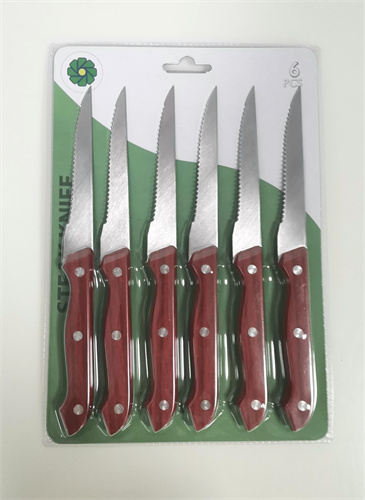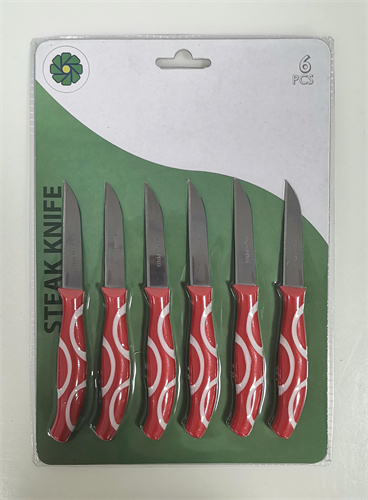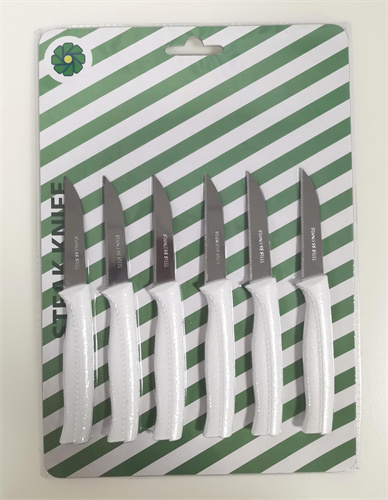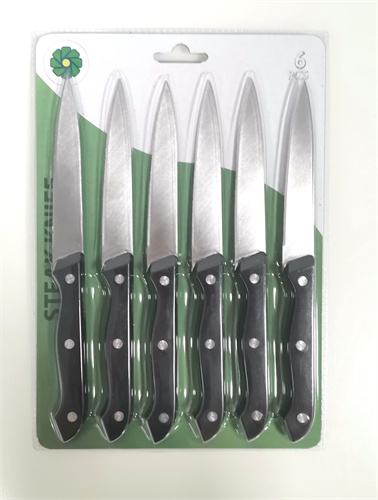

Views: 600 Author: sales@insightknife.com.cn Publish Time: 2025-01-03 Origin: Site








Content Menu
● Understanding Steak Knife Materials
>>> Advantages of Stainless Steel
>>> Disadvantages of Stainless Steel
>> High-Carbon Stainless Steel
>>> Advantages of High-Carbon Stainless Steel
>>> Disadvantages of High-Carbon Stainless Steel
>>> Advantages of Damascus Steel
>>> Disadvantages of Damascus Steel
>> Ceramic
>>> Advantages of Ceramic Knives
>>> Disadvantages of Ceramic Knives
● Choosing the Right Material for Your Needs
>> Budget
● Frequently Asked Questions regarding Steak Knife
>> 1. What is the best material for steak knives?
>> 2. How often should I sharpen my steak knives?
>> 3. Can I put my steak knives in the dishwasher?
>> 4. Are ceramic steak knives suitable for cutting meat?
>> 5. How do I care for my high-carbon stainless steel steak knives?
When it comes to enjoying a perfectly cooked steak, having the right tools is essential. Among these tools, steak knives play a crucial role in ensuring that each slice is smooth and effortless. However, not all steak knives are created equal, and the material used in their construction significantly impacts their performance, durability, and overall user experience. This article delves into the various materials used for steak knives, exploring their advantages and disadvantages, and helping you make an informed choice for your kitchen.
Steak knives can be made from a variety of materials, each offering unique characteristics. The most common materials include stainless steel, high-carbon stainless steel, Damascus steel, and ceramic. Understanding these materials will help you choose the best steak knife for your needs.
Stainless steel is one of the most popular materials for steak knives. It is known for its resistance to rust and corrosion, making it a practical choice for kitchen utensils. This material is an alloy that typically includes iron, carbon, and chromium, which enhances its durability and prevents oxidation.
Durability: Stainless steel knives are robust and can withstand regular use without easily chipping or breaking. This durability makes them suitable for both casual and formal dining settings, ensuring they can handle the rigors of everyday use.
Maintenance: They are relatively easy to maintain, as they can be washed in a dishwasher without fear of damage. This convenience is particularly appealing for busy households where time-saving solutions are valued.
Affordability: Generally, stainless steel knives are more affordable than other high-end materials, making them accessible for most consumers. This affordability allows individuals to invest in a complete set of knives without breaking the bank.
Edge Retention: While stainless steel can be sharp, it may not hold an edge as well as high-carbon options, requiring more frequent sharpening. This can be a drawback for those who prefer a consistently sharp knife for their culinary tasks.
Weight: Some users find stainless steel knives to be heavier, which can affect comfort during use. A heavier knife may lead to fatigue during extended cutting sessions, especially for those who are not accustomed to using heavier utensils.
High-carbon stainless steel combines the best features of stainless steel and carbon steel. This material is often favored by professional chefs and serious home cooks who seek performance and longevity in their kitchen tools.
Sharpness: High-carbon stainless steel can achieve a sharper edge than regular stainless steel, allowing for cleaner cuts. This sharpness is particularly beneficial when slicing through tougher cuts of meat, ensuring a smooth and effortless experience.
Edge Retention: Knives made from this material tend to hold their edge longer, reducing the frequency of sharpening. This characteristic is essential for those who value efficiency in the kitchen and prefer not to spend time honing their knives regularly.
Corrosion Resistance: While it contains carbon, it still retains the rust-resistant properties of stainless steel. This balance makes high-carbon stainless steel a versatile choice for various kitchen environments, from home kitchens to professional settings.


Cost: These knives are typically more expensive than standard stainless steel options. The higher price point reflects the quality and performance benefits, which may be justified for serious cooks but could be a consideration for casual users.
Maintenance: They may require more care to prevent rust, especially if not dried immediately after washing. This additional maintenance can be a deterrent for those who prefer low-maintenance kitchen tools.
Damascus steel is renowned for its distinctive patterns and exceptional performance. It is made by layering different types of steel, which are then forged together. This ancient technique not only creates beautiful blades but also enhances their functionality.
Aesthetic Appeal: The unique patterns on the blade make Damascus knives visually stunning, often considered works of art. This aesthetic quality can elevate the dining experience, making meals feel more special and luxurious.
Performance: These knives are known for their sharpness and edge retention, making them a favorite among culinary enthusiasts. The combination of different steel types results in a blade that can handle various cutting tasks with ease.
Balance: Damascus knives often have a well-balanced feel, enhancing user comfort during cutting tasks. This balance is crucial for precision cutting, allowing chefs to maneuver the knife effortlessly.

Price: Due to the intricate manufacturing process, Damascus knives can be quite expensive. The investment may be worthwhile for those who appreciate craftsmanship and performance but could be a barrier for budget-conscious consumers.
Care Requirements: They may require special care to maintain their appearance and performance, including regular oiling to prevent rust. This maintenance can be time-consuming, which may not appeal to everyone.
Ceramic knives are a modern alternative to traditional metal knives. They are made from zirconium oxide, a hard and durable material that offers unique benefits for specific cutting tasks.
Sharpness: Ceramic knives can be incredibly sharp, allowing for precise cuts. This sharpness is particularly advantageous for slicing fruits and vegetables, where clean cuts are essential for presentation and texture.
Lightweight: They are lighter than metal knives, which can reduce fatigue during extended use. This lightweight nature makes them an excellent choice for those who may struggle with heavier utensils.
Rust Resistance: Ceramic does not rust, making it a low-maintenance option. This feature is particularly appealing for those who want a knife that can withstand moisture without deteriorating.
Brittleness: Ceramic knives can chip or break if dropped or used on hard surfaces. This brittleness limits their versatility, as they are not suitable for all cutting tasks, particularly those involving tougher materials.
Limited Use: They are not suitable for cutting through bones or frozen foods, as they can easily damage the blade. This limitation means that while ceramic knives excel in certain areas, they may not be the best all-around choice for every kitchen.
When selecting a steak knife, consider your personal preferences and how you plan to use the knife. Here are some factors to keep in mind:
If you frequently host dinner parties or enjoy steak regularly, investing in high-carbon stainless steel or Damascus knives may be worthwhile. These materials offer superior performance and longevity, making them ideal for regular use. For occasional use, stainless steel knives may suffice, providing a balance of quality and affordability.
Your budget will significantly influence your choice of material. Stainless steel knives are generally more affordable, while high-carbon and Damascus options can be more expensive. Determine how much you are willing to spend before making a decision. Remember that investing in quality knives can enhance your cooking experience and may save you money in the long run by reducing the need for replacements.
Consider how much time you are willing to dedicate to maintaining your knives. If you prefer low-maintenance options, stainless steel or ceramic knives may be more suitable. On the other hand, if you enjoy caring for your tools, high-carbon stainless steel or Damascus knives can provide excellent performance with proper care. Understanding your maintenance preferences will help you choose a knife that fits seamlessly into your lifestyle.
If the appearance of your kitchen tools matters to you, Damascus steel knives are a beautiful choice. Their unique patterns can add a touch of elegance to your dining experience. Additionally, the aesthetic appeal of a knife can enhance the overall presentation of your meals, making them feel more special and thoughtfully prepared.
Choosing the best material for steak knives involves understanding the characteristics of each option available. Stainless steel offers durability and ease of maintenance, while high-carbon stainless steel provides superior sharpness and edge retention. Damascus steel stands out for its beauty and performance, while ceramic knives offer a lightweight and rust-resistant alternative. By considering your usage habits, budget, maintenance preferences, and aesthetic desires, you can select the perfect steak knife material that enhances your dining experience.
Investing in quality steak knives not only elevates your meal presentation but also ensures that each bite is as enjoyable as the last. Whether you opt for the classic appeal of stainless steel or the artistry of Damascus, the right steak knife will make all the difference at your table. Ultimately, the right choice will reflect your personal style and enhance your culinary adventures, making every meal a memorable occasion.

The best material for steak knives depends on personal preference and usage. High-carbon stainless steel is often considered the best for its sharpness and edge retention, while stainless steel is favored for its durability and low maintenance. Damascus steel offers aesthetic appeal and performance, while ceramic knives are lightweight and rust-resistant.
The frequency of sharpening steak knives depends on the material and usage. High-carbon stainless steel knives may need sharpening every few months with regular use, while stainless steel knives might require sharpening less often. Ceramic knives can maintain their sharpness longer but may need specialized sharpening tools.
While some stainless steel knives are dishwasher safe, it is generally recommended to hand wash steak knives to preserve their sharpness and prevent damage. High-carbon stainless steel and Damascus knives, in particular, should be washed by hand and dried immediately to prevent rust and maintain their quality.
Ceramic steak knives can cut meat effectively, especially softer cuts. However, they are not ideal for tougher meats or cutting through bones, as they can chip or break. For best results, use ceramic knives for slicing cooked meats and softer foods.
To care for high-carbon stainless steel steak knives, wash them by hand with mild soap and water, and dry them immediately to prevent rust. Regularly honing the blade will help maintain its sharpness, and occasional oiling can protect the blade from moisture and corrosion.